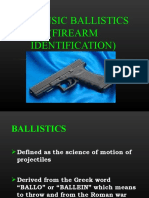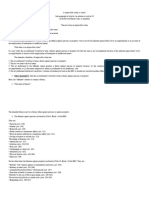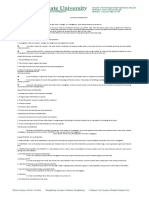0 ratings0% found this document useful (0 votes)
150 viewsForensic Anthropology
Forensic Anthropology
Uploaded by
Arry Ja DahThis document discusses the field of forensic anthropology, which analyzes human skeletal remains to determine biological profiles and circumstances of death. It provides an overview of the history and development of the field from the 1800s to present day. Key figures who advanced the study are mentioned and methods of gathering and analyzing data from skeletal remains are outlined. The goal of forensic anthropology is to assist investigations by determining identity and cause and manner of death.
Copyright:
© All Rights Reserved
Available Formats
Download as PPTX, PDF, TXT or read online from Scribd
Forensic Anthropology
Forensic Anthropology
Uploaded by
Arry Ja Dah0 ratings0% found this document useful (0 votes)
150 views21 pagesThis document discusses the field of forensic anthropology, which analyzes human skeletal remains to determine biological profiles and circumstances of death. It provides an overview of the history and development of the field from the 1800s to present day. Key figures who advanced the study are mentioned and methods of gathering and analyzing data from skeletal remains are outlined. The goal of forensic anthropology is to assist investigations by determining identity and cause and manner of death.
Original Description:
forensik antro
Copyright
© © All Rights Reserved
Available Formats
PPTX, PDF, TXT or read online from Scribd
Share this document
Did you find this document useful?
Is this content inappropriate?
This document discusses the field of forensic anthropology, which analyzes human skeletal remains to determine biological profiles and circumstances of death. It provides an overview of the history and development of the field from the 1800s to present day. Key figures who advanced the study are mentioned and methods of gathering and analyzing data from skeletal remains are outlined. The goal of forensic anthropology is to assist investigations by determining identity and cause and manner of death.
Copyright:
© All Rights Reserved
Available Formats
Download as PPTX, PDF, TXT or read online from Scribd
Download as pptx, pdf, or txt
0 ratings0% found this document useful (0 votes)
150 views21 pagesForensic Anthropology
Forensic Anthropology
Uploaded by
Arry Ja DahThis document discusses the field of forensic anthropology, which analyzes human skeletal remains to determine biological profiles and circumstances of death. It provides an overview of the history and development of the field from the 1800s to present day. Key figures who advanced the study are mentioned and methods of gathering and analyzing data from skeletal remains are outlined. The goal of forensic anthropology is to assist investigations by determining identity and cause and manner of death.
Copyright:
© All Rights Reserved
Available Formats
Download as PPTX, PDF, TXT or read online from Scribd
Download as pptx, pdf, or txt
You are on page 1of 21
Introduction
The field of study that deals with the analysis
of human skeletal remains
Gather information persons represented by
skeletal remains; circumstances
surrounding the deaths
Applied science, embraces both
anthropological and forensic studies
Determine biological profile
Identify the cause and manner of death
Determine the postmortem interval
Assist in locating and recovering (forensic
investigation)
Provide information useful in obtaining
positive identification
Thomas Dwight (1843-1911)
Researched methods for determining
biological profile
The first to write articles and essays on the
topic of human skeletal identification
The papers – apply knowledge of the human
skeleton to forensic situation
Formative Period (1800s – 1930s)
Criminal cases identification
Publication – scientific writings: articles,
books
Anthropologists:
Ales Hrdlicka
T.Wingate Todd
Wilton Marion Krogman
Consolidation Period (1939 – 1971)
Several events have a great impact:
World War II – killed service man
(Stewart, Trotter)
Korean War – servicemen killed in action
(Stewart, McKern)
Numerous articles on aspects of skeletal
identification (Stewart)
Modern Period (1972 to the present)
Physical Anthropology Section meeting –
American Academy of Forensic Sciences
(AAFS)
American Board of Forensic Anthropology
(ABFA) – ensuring the competence of
persons who practice forensic anthropology
Forensic Anthropology Data Bank
(University of Tennessee, Knoxville) –
collect information on documented forensic
cases
Main expert:
Medical examiner, coronors, forensic
pathologist – perform their function on
“fresh” bodies
Other expert:
Forensic anthropology, forensic archaeology,
forensic odontologist
Also:
Ballistic, forensic entomology, forensic
botany
Arethe remains human?
Represent single individual or the
commingled remains?
When did death occur?
How old was the decedent?
What was the decedent’s sex?
What was the decedent’s race?
What was the decedent’s stature? Body
weight? Physique?
Any significant anatomical anomalies?
What was the cause of death?
What was the manner of death?
Data Gathering
Anthroposcopy
Visual inspection – identifying traits of a
qualitative nature (with aid of lens or x-ray)
Osteometry
Metric methods – quantify anthroposcopic
characteristic (with calipers or osteometric
board)
Chemical
Analyzing the chemical makeup of certain
structure of the skeleton and associated
matters (sampling)
Histology
Microstructure of bone and teeth (cutting off
thin slice, staining, view under microscope)
Data Analysis
Decision table
to judge the importance of conflicting
information – single conclusion
Range chart
visual representation of multiple ranges of
estimates – central tendency
Indexes
numerical expression of the shape of a
structure
Discriminant function
Calculating a numerical expression of
shape – it can be used when more than two
measurements are available
Regression
Determined the value of one characteristic
from the values of other characteristics
You might also like
- A Module in Forensic 2Document88 pagesA Module in Forensic 2Cristian Joshua C. SalibongcogonNo ratings yet
- Vanezis, P. (2022) - The Pathology of Sharp Force TraumaDocument323 pagesVanezis, P. (2022) - The Pathology of Sharp Force TraumaPrincess Rosalie RossengNo ratings yet
- Communication Works Gamble 10th Edition PDFDocument2 pagesCommunication Works Gamble 10th Edition PDFDanielle25% (4)
- The Art of Forensic Detection and Sherlock Holmes by Robert IngDocument5 pagesThe Art of Forensic Detection and Sherlock Holmes by Robert IngRobert IngNo ratings yet
- Chapter 1. Introduction To Forensic Anthropology 2024Document28 pagesChapter 1. Introduction To Forensic Anthropology 2024Prince GaringanNo ratings yet
- Chapter 16 Forensic EntomologyDocument11 pagesChapter 16 Forensic EntomologyYanna Rizkia100% (1)
- Investigation of HomicideDocument15 pagesInvestigation of HomicideArgie DionioNo ratings yet
- Lecture Notes Forensic BallisticDocument9 pagesLecture Notes Forensic BallisticArjay MartinezNo ratings yet
- 1 CiDocument126 pages1 CiSeagal Umar100% (2)
- Forensic BallisticsDocument169 pagesForensic BallisticsCounter IntelligenceNo ratings yet
- Cdi NotesDocument12 pagesCdi NotesJhasper John Corpuz MalaqueNo ratings yet
- Fundamental Principles and Theory of Crime Scene PhotographyDocument13 pagesFundamental Principles and Theory of Crime Scene Photographyछेरबहादुर लेउवाNo ratings yet
- Henry Fingerprint ClassificationDocument7 pagesHenry Fingerprint Classificationkeshav100% (1)
- Best Practice in Forensic Entomology - Standards and GuidelinesDocument15 pagesBest Practice in Forensic Entomology - Standards and Guidelinesrmarin_90No ratings yet
- Forensic BallisticsDocument51 pagesForensic BallisticsLance DairoNo ratings yet
- Chapter12 ForensicsDocument31 pagesChapter12 ForensicsMohamed Ali AbdiNo ratings yet
- Presentation On FORENSIC DOCUMENT EXAMINATIONDocument27 pagesPresentation On FORENSIC DOCUMENT EXAMINATIONDerfcire RazipalNo ratings yet
- Forensic PathologyDocument8 pagesForensic Pathologyberolyan06No ratings yet
- Celdran V PeopleDocument24 pagesCeldran V PeopleacolumnofsmokeNo ratings yet
- 4 20 20 Personal IdentificationDocument59 pages4 20 20 Personal IdentificationMary Rose Baluran100% (1)
- Forensic Anthro Module PDFDocument38 pagesForensic Anthro Module PDFAisyah RieskiuNo ratings yet
- Lesson 1. Personal IdentificationDocument7 pagesLesson 1. Personal Identificationsofia ruiz100% (1)
- Forensic Science IntroDocument17 pagesForensic Science IntroEdward Arthur Iskandar100% (1)
- Forensic Science Vocabulary DictionaryDocument8 pagesForensic Science Vocabulary Dictionaryandrewgomez9229No ratings yet
- Evidence Collection FormsDocument6 pagesEvidence Collection Formsapi-276338902No ratings yet
- Hairs and FibersDocument16 pagesHairs and Fibersapi-262815720No ratings yet
- ARC CDI NotesDocument109 pagesARC CDI NotesKleen NateNo ratings yet
- Module 7 - Blood and Blood StainsDocument7 pagesModule 7 - Blood and Blood StainsKevin Lucas100% (1)
- Impression EvidenceDocument8 pagesImpression Evidenceapi-262815720No ratings yet
- Entomotoxicology: Dayananda R, Kiran JDocument4 pagesEntomotoxicology: Dayananda R, Kiran Jrannia100% (1)
- Crimnalistic 5 Polygraphy Lie Detection TechniquesDocument38 pagesCrimnalistic 5 Polygraphy Lie Detection TechniquesQueenda Arcibal100% (1)
- Medico-Legal Investigation of Deaths: DeathDocument113 pagesMedico-Legal Investigation of Deaths: DeathRoman MamunNo ratings yet
- Positivist School: Biological Explanation: 1. Physical Trait TheoriesDocument11 pagesPositivist School: Biological Explanation: 1. Physical Trait Theoriessaba iqbalNo ratings yet
- FP ImpressionDocument6 pagesFP ImpressionAlea May Valdez MendozaNo ratings yet
- Saferstein CriminalisticsDocument10 pagesSaferstein CriminalisticsRico T. Musong100% (1)
- Chapter I: Importance of Personal Identification in Criminal InvestigationDocument3 pagesChapter I: Importance of Personal Identification in Criminal InvestigationMarcel CataynaNo ratings yet
- Forensic EntomologyDocument15 pagesForensic EntomologyvperezNo ratings yet
- Forensic BallisticsDocument182 pagesForensic BallisticsRochel Mae Dupalco100% (1)
- Final Examination in Legal MedicineDocument21 pagesFinal Examination in Legal MedicineFrances Angelie NacepoNo ratings yet
- Art 4 Impossible CrimeDocument83 pagesArt 4 Impossible CrimeKeith MartinezNo ratings yet
- CDI201 Special Crime Investigation With Legal MedicineDocument19 pagesCDI201 Special Crime Investigation With Legal MedicineAldrin Jay Villanueva LasagasNo ratings yet
- Forensic Entomology - AndersonDocument10 pagesForensic Entomology - AndersonSarah van WermeskerkenNo ratings yet
- Forensic Studies Module 2 - Physical Evidence & The Legal SystemDocument50 pagesForensic Studies Module 2 - Physical Evidence & The Legal SystemMarkus WolfeNo ratings yet
- Kent 5Document3 pagesKent 5Suneth Kaye Javellana50% (2)
- LM6 - Medico-Legal Investigation of DeathDocument73 pagesLM6 - Medico-Legal Investigation of DeathBa ShangNo ratings yet
- Institutional Correction MidtermDocument20 pagesInstitutional Correction MidtermAspher Ian GummongNo ratings yet
- Fingerprint PatternsDocument1 pageFingerprint PatternsJhai Jhai Dumsyy100% (1)
- Dactylos PDFDocument151 pagesDactylos PDFZenny Jabuen100% (2)
- Crime Scene Search MethodsDocument2 pagesCrime Scene Search MethodsVîšhwąkřmą HõńëÿNo ratings yet
- CA 2 PART 1 Non Institutional CorrectionsDocument39 pagesCA 2 PART 1 Non Institutional CorrectionsJay Macapobre Davin100% (1)
- The Polygraph HistoryDocument10 pagesThe Polygraph HistoryDave Pelingon RuizNo ratings yet
- Cdi Chapter 1Document61 pagesCdi Chapter 1SANTOYO,ANGEL ROMUALDONo ratings yet
- TOPIC 2 Physical Evidence PDFDocument13 pagesTOPIC 2 Physical Evidence PDFNurul Asyiqin KhairuddinNo ratings yet
- To Criminalistics: (For The FILIPINO Criminalist)Document62 pagesTo Criminalistics: (For The FILIPINO Criminalist)Ej VianzonNo ratings yet
- Hair and Fiber PDFDocument51 pagesHair and Fiber PDFPhoebeA CalupitNo ratings yet
- MODULE 4 IN P.E. 4 (Fundamentals of Marksmanship) : Basic Firearms LawsDocument32 pagesMODULE 4 IN P.E. 4 (Fundamentals of Marksmanship) : Basic Firearms LawsDesiree Ann TaguibaoNo ratings yet
- The History FingerprintDocument63 pagesThe History FingerprintEdzel PeňaNo ratings yet
- Ballistics - Intro 1 NOtesDocument15 pagesBallistics - Intro 1 NOtesRaso D. OrongNo ratings yet
- Unit 3 Forensic AnthropologyDocument32 pagesUnit 3 Forensic AnthropologyTina SharmaNo ratings yet
- Forensic AnthropologyDocument4 pagesForensic AnthropologySahilNo ratings yet
- UntitledDocument236 pagesUntitledRENE MARANONo ratings yet
- Fast 3102 1108 GBDocument2 pagesFast 3102 1108 GBBecirspahic AlmirNo ratings yet
- SafariDocument88 pagesSafariishaNo ratings yet
- Opening An Amazon AccountDocument2 pagesOpening An Amazon Accountgeneticheart28No ratings yet
- HighwayDocument4 pagesHighwayShaneene Berlyn AgulayNo ratings yet
- Village of The WatermillsDocument1 pageVillage of The WatermillsJenny Elles0% (1)
- Los Angeles: Luka Arapovic 3.eDocument19 pagesLos Angeles: Luka Arapovic 3.eLuka ArapovićNo ratings yet
- John J. Collins (1982) - The Apocalyptic Technique. Setting and Function in The Book of Watchers. The Catholic Biblical Quarterly 44.1, Pp. 91-111Document22 pagesJohn J. Collins (1982) - The Apocalyptic Technique. Setting and Function in The Book of Watchers. The Catholic Biblical Quarterly 44.1, Pp. 91-111Olestar 2023-06-27No ratings yet
- Task Risk Assessment Engineering Kinetics (PVT.) LTD: Risk Evaluation (Refer To Evaluation Form)Document3 pagesTask Risk Assessment Engineering Kinetics (PVT.) LTD: Risk Evaluation (Refer To Evaluation Form)andreNo ratings yet
- T Tal Plant: UDC 6300 Process ControllerDocument8 pagesT Tal Plant: UDC 6300 Process ControllerisctomaslopezNo ratings yet
- Legal Bases For TertiaryDocument42 pagesLegal Bases For Tertiaryanon_1815967210% (1)
- Astm D6373-21Document5 pagesAstm D6373-21bechir mzoughiNo ratings yet
- Sheave Design - TimcoDocument10 pagesSheave Design - TimcotungNo ratings yet
- Statement of PurposeDocument2 pagesStatement of PurposePAVAN KUMAR THATANo ratings yet
- B17 - BEAM - Rev ADocument1 pageB17 - BEAM - Rev ADass MNo ratings yet
- Employee Onboarding and Satisfaction in US Manufacturing CompaniesDocument12 pagesEmployee Onboarding and Satisfaction in US Manufacturing CompaniesShaifali GargNo ratings yet
- Egregore PDFDocument3 pagesEgregore PDFRoberto Lopes Jesus100% (2)
- EyeletdrawingDocument44 pagesEyeletdrawingM PraveenNo ratings yet
- Power of Thought Henry Thomas HamblinDocument38 pagesPower of Thought Henry Thomas HamblinhabiotoNo ratings yet
- Guy TowerDocument103 pagesGuy Towerashraf04_ceNo ratings yet
- Multiple Choice Enzymes Plant and Animal NutritionDocument44 pagesMultiple Choice Enzymes Plant and Animal Nutritionliufanjing07No ratings yet
- Insight in Psychiatry by Ivana MarkovDocument345 pagesInsight in Psychiatry by Ivana MarkovmalextomasNo ratings yet
- DesigfoA6V11852707 enDocument4 pagesDesigfoA6V11852707 enAjdin BuljubasicNo ratings yet
- Chapter 7 ControllingDocument19 pagesChapter 7 ControllingElaine Aranilla Alcantara100% (2)
- Full download The Archaeology of Palestine and the Bible Gorgias Classic Archaeological Reprints 5 1st Edition William Albright pdf docxDocument60 pagesFull download The Archaeology of Palestine and the Bible Gorgias Classic Archaeological Reprints 5 1st Edition William Albright pdf docxnugenvesga17100% (7)
- Input - OutputDocument15 pagesInput - Outputsushil4056No ratings yet
- NIBCO Fire Protection Valve..... (1)Document22 pagesNIBCO Fire Protection Valve..... (1)Mary LCNo ratings yet
- Innovation and Export Behaviour at The Firm LevelDocument13 pagesInnovation and Export Behaviour at The Firm LevelAnisur Rahman FaroqueNo ratings yet
- TESUP Magnum5 Wind Turbine User ManualDocument30 pagesTESUP Magnum5 Wind Turbine User ManualHugoNo ratings yet
























































































